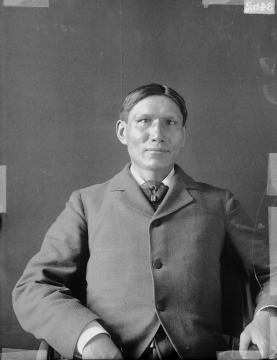1890: Dakota doctor witnesses Wounded Knee aftermath
Dr. Charles Eastman, a Dakota, hears reports of a battle. Despite a blizzard and Army efforts to delay him, three days later he arrives with 85 Lakotas and 10 to 15 white civilians who plan to bury the dead at Wounded Knee. Although he had been told that the incident was a battle, Eastman writes that it was massacre, in which those who fled were “relentlessly hunted down”. Amid the destruction he finds a baby girl, named Zinkala Nuni by Lakota survivors, who is adopted by an Army officer.
“Fully three miles from the scene of the massacre we found the body of a woman completely covered with a blanket of snow, and from this point on we found them scattered along as they had been relentlessly hunted down and slaughtered, while fleeing for their lives. Some of our people discovered relatives or friends among the dead, and there was much wailing and mourning. When we reached the spot where the Indian camp had stood, among the fragments of burned tents and other belongings, we saw frozen bodies lying close together or piled one upon another,” Charles Eastman wrote. “It took all my nerve to keep my composure in the face of this spectacle, and of the grief of my Indian companions, nearly everyone of whom was crying aloud or singing his death song.”
- Theme
- Native Rights
- Region
- Great Plains
Dr. Charles Eastman
Courtesy National Anthropological Archives, Smithsonian Institution
